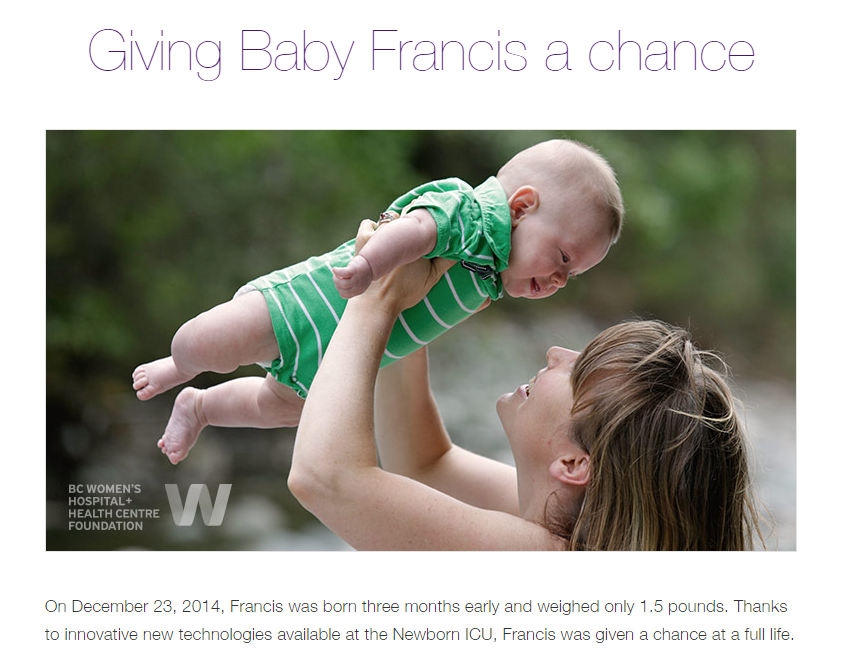Storytelling is the oldest communication form and it undoubtedly unites us all, regardless of culture or country. It is this communication around the shared human condition that spurs empathy and philanthropic action. Writing a compelling story that gets people to take action and donate to your cause may seem daunting, if you’ve ever told an anecdote that had your guests laughing at the dinner table, then I promise that you can tell your nonprofit organization’s story in a captivating way that converts.
Start with your main character
 What’s a story without a hero? By putting a face to your cause, people are able to identify with the person, and the problem they are facing, even if it’s a problem faced by many people. Canadian telecom company Telus does a fantastic job of this with their Give Where We Live program. In their cause marketing campaign to support the Newborn ICU at the BC Women’s Hospital, they chose the story of a premature baby named Francis who was saved by their work. Nonprofits can do this when representing themselves too, often to great results.
What’s a story without a hero? By putting a face to your cause, people are able to identify with the person, and the problem they are facing, even if it’s a problem faced by many people. Canadian telecom company Telus does a fantastic job of this with their Give Where We Live program. In their cause marketing campaign to support the Newborn ICU at the BC Women’s Hospital, they chose the story of a premature baby named Francis who was saved by their work. Nonprofits can do this when representing themselves too, often to great results.
What you need
- If you have the individual’s permission, share information like the individual’s name, location, and personal goals
- Let the individual tell their story. It will be more even more impactful if it’s told in their own words (with their own voice is even better! Video content is always a great story-telling tool).
- Use pictures or video of the person so your supporters can really connect with your hero. They should feel like they know them well.
Hit hard with a startling fact or statistic
The shock factor is a sure way to get an audience’s attention- and you can achieve it in a compelling, respectful, and appropriate way. In an article in the Harvard Business Review, Genuine Interactive says that in their research they found that, “69% of the consumers told us they are most likely to remember a PSA that presents the facts in either a surprising or a straightforward way, while only 11% said they tend to remember those that make them laugh, and 20% said those that scare them.”
Keeping this in mind, consider starting an email, blog post, or your crowdfunding story and tagline with an arresting fact that grabs your supporters’ attention and draws them in.
Be more than a cause – Inspire a quest
For some social impact organizations (especially those searching for cures to diseases) presenting your cause as a quest is a great way to engage your community in seeking the ‘holy grail’ of a cure with you. Quests draw people in and unite them under a common goal. They make the impact of a donation very well known and inspire people to action. It’s also a great way to use the Goal Proximity effect to your advantage, as you show your progress along the quest. Studies show that people become more likely to contribute to a crowdfunding campaign as it gets closer and closer to its goal.
Don’t forget:
- Set a solid goal, whether a cure or a fundraising milestone, to motivate your audience. Try to keep them SMART (Specific, Measurable, Achievable, Results-focused, and Time-bound).
- Share your progress updates and the issues you have solved along the road to show what makes your long-term goals possible.
Keep a strong emphasis on social sharing and earned media
Award-winning successful campaigns don’t rely on one type of storytelling- they provided content designed specifically for what’s effective across each social channel.
Make sure your crowdfunding campaign is social media integrated to get the masses disseminating your message for you in addition to your own original content. Not sure if your campaign is? Do you have sponsors that need recognition built into your social sharing? Sponsifi can take care of that for you. After all, the best story is the one that other people excitedly on behalf of your cause.
Did we miss something? Tweet us and let us know your non-profit story-telling tactics.

